Comprehensive Report on Accounting for Share Buy Back Practices
VerifiedAdded on 2023/06/04
|8
|1579
|388
Report
AI Summary
This report provides a detailed analysis of accounting for share buybacks, focusing on the cost method and its implications for financial reporting. It explains how companies repurchase their own shares, the accounting treatment of treasury stock as a contra-equity account, and the impact on key financial metrics such as return on capital and return on equity. The report also covers the journal entries required for share buybacks, including the debit and credit entries for treasury stock, cash, and paid-in capital. Furthermore, it addresses the accounting for impairment loss, including the allocation of impairment to different assets and the necessary journal entries. The report concludes with recommendations for companies regarding the use of surplus funds for share repurchases and the importance of proper accounting practices. Desklib offers this and many other solved assignments for students.

Running head: ACCOUNTING
Accounting
Name of the Student:
Name of the University:
Authors Note:
Accounting
Name of the Student:
Name of the University:
Authors Note:
Paraphrase This Document
Need a fresh take? Get an instant paraphrase of this document with our AI Paraphraser
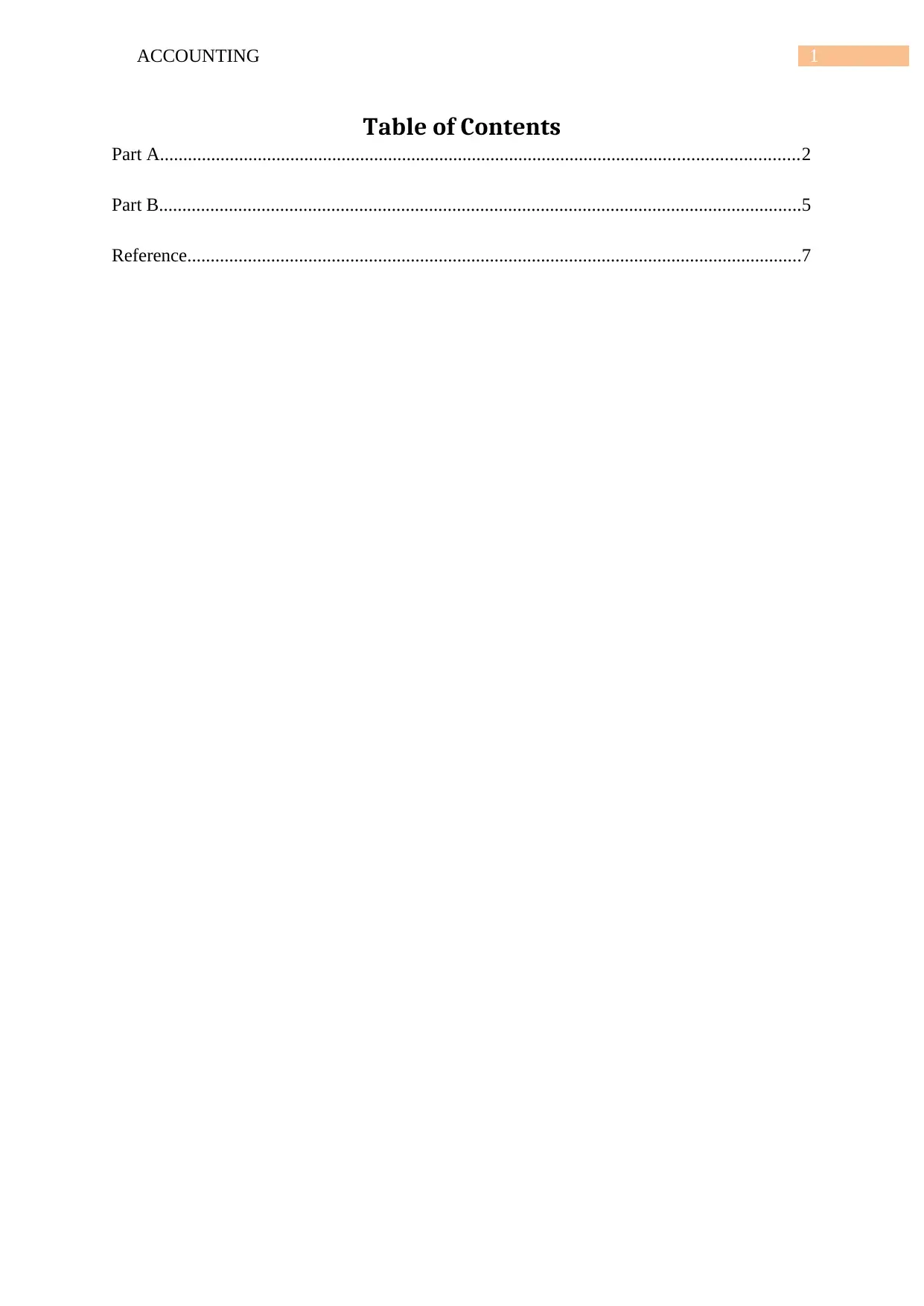
1ACCOUNTING
Table of Contents
Part A.........................................................................................................................................2
Part B..........................................................................................................................................5
Reference....................................................................................................................................7
Table of Contents
Part A.........................................................................................................................................2
Part B..........................................................................................................................................5
Reference....................................................................................................................................7
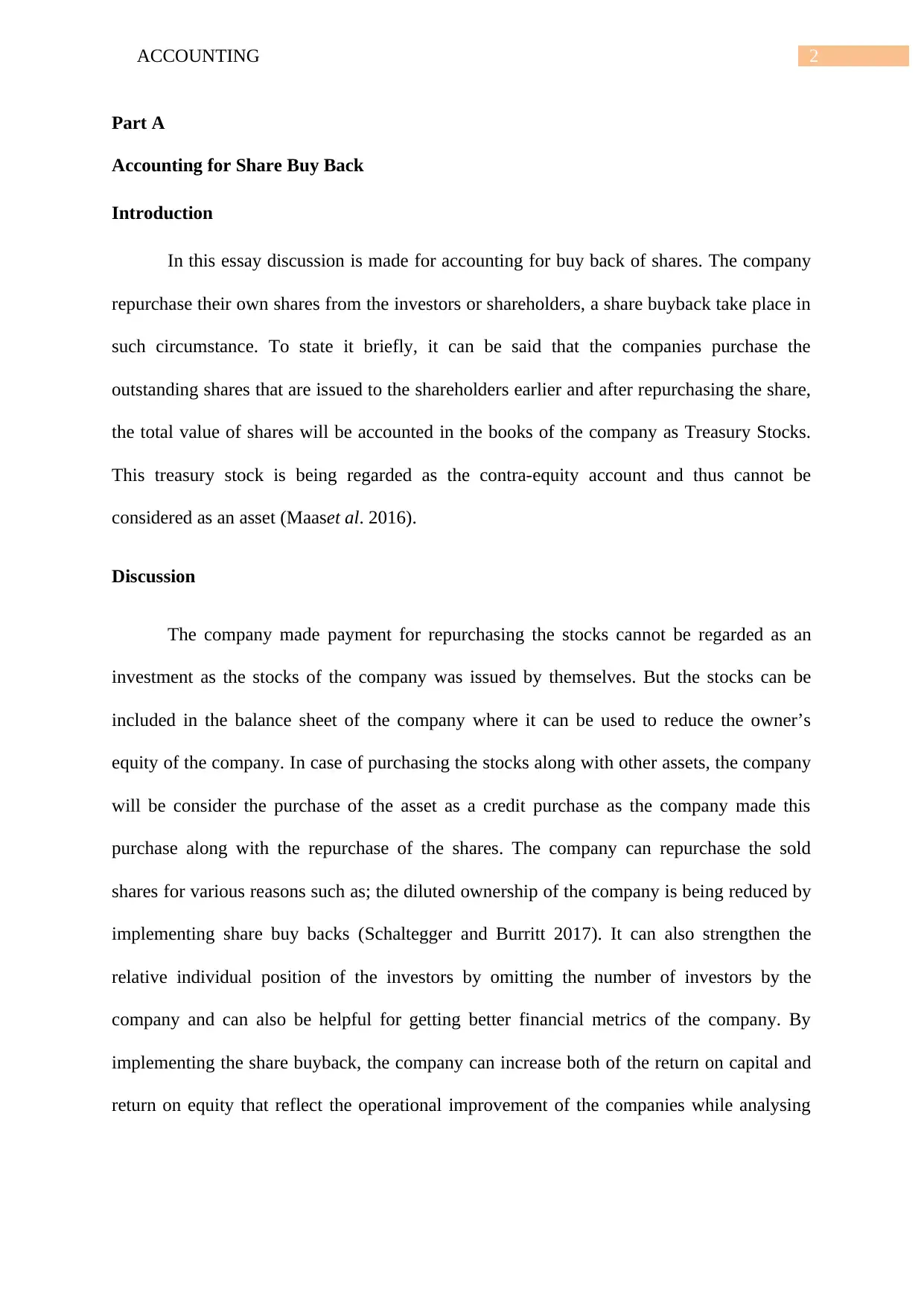
2ACCOUNTING
Part A
Accounting for Share Buy Back
Introduction
In this essay discussion is made for accounting for buy back of shares. The company
repurchase their own shares from the investors or shareholders, a share buyback take place in
such circumstance. To state it briefly, it can be said that the companies purchase the
outstanding shares that are issued to the shareholders earlier and after repurchasing the share,
the total value of shares will be accounted in the books of the company as Treasury Stocks.
This treasury stock is being regarded as the contra-equity account and thus cannot be
considered as an asset (Maaset al. 2016).
Discussion
The company made payment for repurchasing the stocks cannot be regarded as an
investment as the stocks of the company was issued by themselves. But the stocks can be
included in the balance sheet of the company where it can be used to reduce the owner’s
equity of the company. In case of purchasing the stocks along with other assets, the company
will be consider the purchase of the asset as a credit purchase as the company made this
purchase along with the repurchase of the shares. The company can repurchase the sold
shares for various reasons such as; the diluted ownership of the company is being reduced by
implementing share buy backs (Schaltegger and Burritt 2017). It can also strengthen the
relative individual position of the investors by omitting the number of investors by the
company and can also be helpful for getting better financial metrics of the company. By
implementing the share buyback, the company can increase both of the return on capital and
return on equity that reflect the operational improvement of the companies while analysing
Part A
Accounting for Share Buy Back
Introduction
In this essay discussion is made for accounting for buy back of shares. The company
repurchase their own shares from the investors or shareholders, a share buyback take place in
such circumstance. To state it briefly, it can be said that the companies purchase the
outstanding shares that are issued to the shareholders earlier and after repurchasing the share,
the total value of shares will be accounted in the books of the company as Treasury Stocks.
This treasury stock is being regarded as the contra-equity account and thus cannot be
considered as an asset (Maaset al. 2016).
Discussion
The company made payment for repurchasing the stocks cannot be regarded as an
investment as the stocks of the company was issued by themselves. But the stocks can be
included in the balance sheet of the company where it can be used to reduce the owner’s
equity of the company. In case of purchasing the stocks along with other assets, the company
will be consider the purchase of the asset as a credit purchase as the company made this
purchase along with the repurchase of the shares. The company can repurchase the sold
shares for various reasons such as; the diluted ownership of the company is being reduced by
implementing share buy backs (Schaltegger and Burritt 2017). It can also strengthen the
relative individual position of the investors by omitting the number of investors by the
company and can also be helpful for getting better financial metrics of the company. By
implementing the share buyback, the company can increase both of the return on capital and
return on equity that reflect the operational improvement of the companies while analysing
⊘ This is a preview!⊘
Do you want full access?
Subscribe today to unlock all pages.

Trusted by 1+ million students worldwide
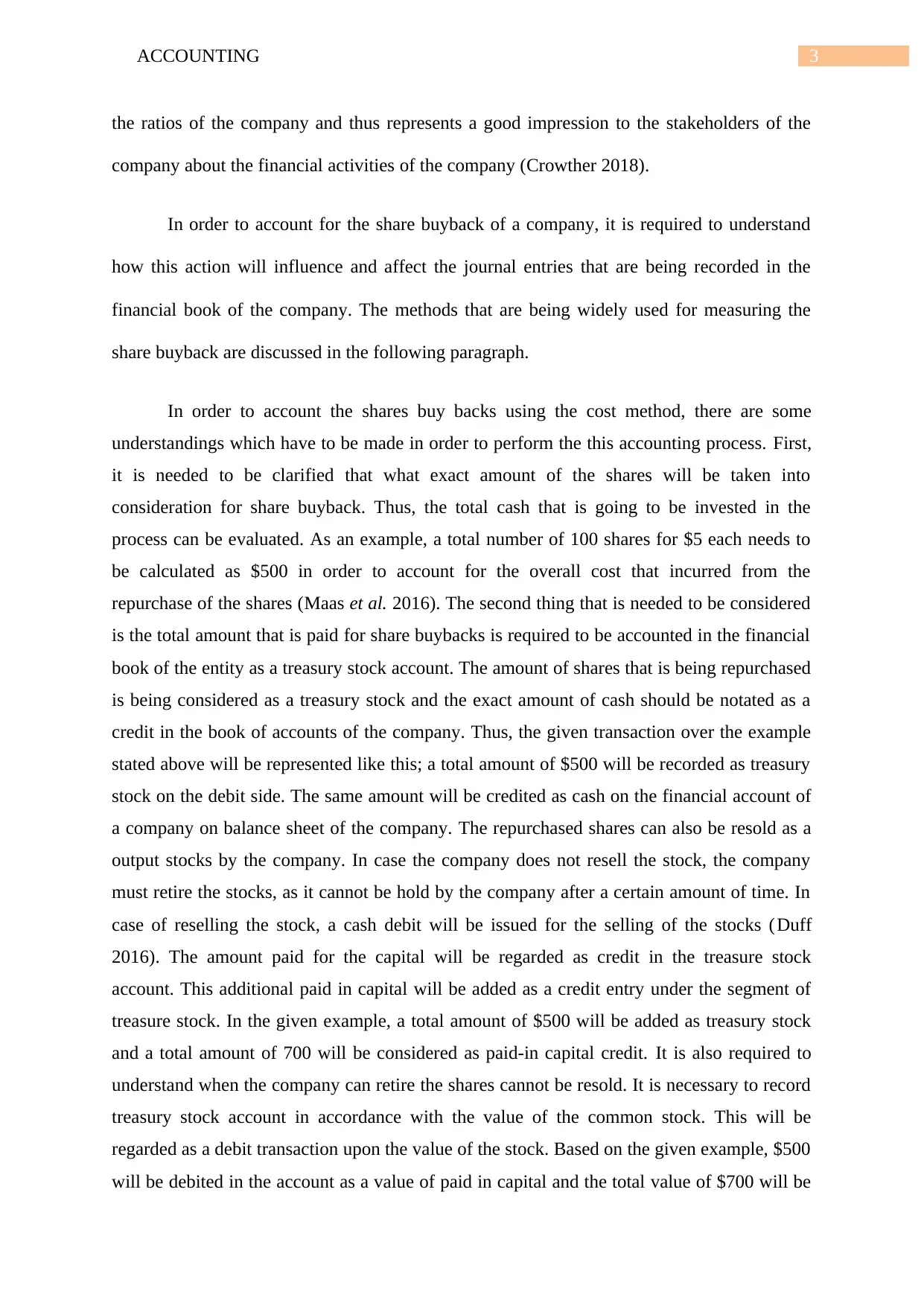
3ACCOUNTING
the ratios of the company and thus represents a good impression to the stakeholders of the
company about the financial activities of the company (Crowther 2018).
In order to account for the share buyback of a company, it is required to understand
how this action will influence and affect the journal entries that are being recorded in the
financial book of the company. The methods that are being widely used for measuring the
share buyback are discussed in the following paragraph.
In order to account the shares buy backs using the cost method, there are some
understandings which have to be made in order to perform the this accounting process. First,
it is needed to be clarified that what exact amount of the shares will be taken into
consideration for share buyback. Thus, the total cash that is going to be invested in the
process can be evaluated. As an example, a total number of 100 shares for $5 each needs to
be calculated as $500 in order to account for the overall cost that incurred from the
repurchase of the shares (Maas et al. 2016). The second thing that is needed to be considered
is the total amount that is paid for share buybacks is required to be accounted in the financial
book of the entity as a treasury stock account. The amount of shares that is being repurchased
is being considered as a treasury stock and the exact amount of cash should be notated as a
credit in the book of accounts of the company. Thus, the given transaction over the example
stated above will be represented like this; a total amount of $500 will be recorded as treasury
stock on the debit side. The same amount will be credited as cash on the financial account of
a company on balance sheet of the company. The repurchased shares can also be resold as a
output stocks by the company. In case the company does not resell the stock, the company
must retire the stocks, as it cannot be hold by the company after a certain amount of time. In
case of reselling the stock, a cash debit will be issued for the selling of the stocks (Duff
2016). The amount paid for the capital will be regarded as credit in the treasure stock
account. This additional paid in capital will be added as a credit entry under the segment of
treasure stock. In the given example, a total amount of $500 will be added as treasury stock
and a total amount of 700 will be considered as paid-in capital credit. It is also required to
understand when the company can retire the shares cannot be resold. It is necessary to record
treasury stock account in accordance with the value of the common stock. This will be
regarded as a debit transaction upon the value of the stock. Based on the given example, $500
will be debited in the account as a value of paid in capital and the total value of $700 will be
the ratios of the company and thus represents a good impression to the stakeholders of the
company about the financial activities of the company (Crowther 2018).
In order to account for the share buyback of a company, it is required to understand
how this action will influence and affect the journal entries that are being recorded in the
financial book of the company. The methods that are being widely used for measuring the
share buyback are discussed in the following paragraph.
In order to account the shares buy backs using the cost method, there are some
understandings which have to be made in order to perform the this accounting process. First,
it is needed to be clarified that what exact amount of the shares will be taken into
consideration for share buyback. Thus, the total cash that is going to be invested in the
process can be evaluated. As an example, a total number of 100 shares for $5 each needs to
be calculated as $500 in order to account for the overall cost that incurred from the
repurchase of the shares (Maas et al. 2016). The second thing that is needed to be considered
is the total amount that is paid for share buybacks is required to be accounted in the financial
book of the entity as a treasury stock account. The amount of shares that is being repurchased
is being considered as a treasury stock and the exact amount of cash should be notated as a
credit in the book of accounts of the company. Thus, the given transaction over the example
stated above will be represented like this; a total amount of $500 will be recorded as treasury
stock on the debit side. The same amount will be credited as cash on the financial account of
a company on balance sheet of the company. The repurchased shares can also be resold as a
output stocks by the company. In case the company does not resell the stock, the company
must retire the stocks, as it cannot be hold by the company after a certain amount of time. In
case of reselling the stock, a cash debit will be issued for the selling of the stocks (Duff
2016). The amount paid for the capital will be regarded as credit in the treasure stock
account. This additional paid in capital will be added as a credit entry under the segment of
treasure stock. In the given example, a total amount of $500 will be added as treasury stock
and a total amount of 700 will be considered as paid-in capital credit. It is also required to
understand when the company can retire the shares cannot be resold. It is necessary to record
treasury stock account in accordance with the value of the common stock. This will be
regarded as a debit transaction upon the value of the stock. Based on the given example, $500
will be debited in the account as a value of paid in capital and the total value of $700 will be
Paraphrase This Document
Need a fresh take? Get an instant paraphrase of this document with our AI Paraphraser
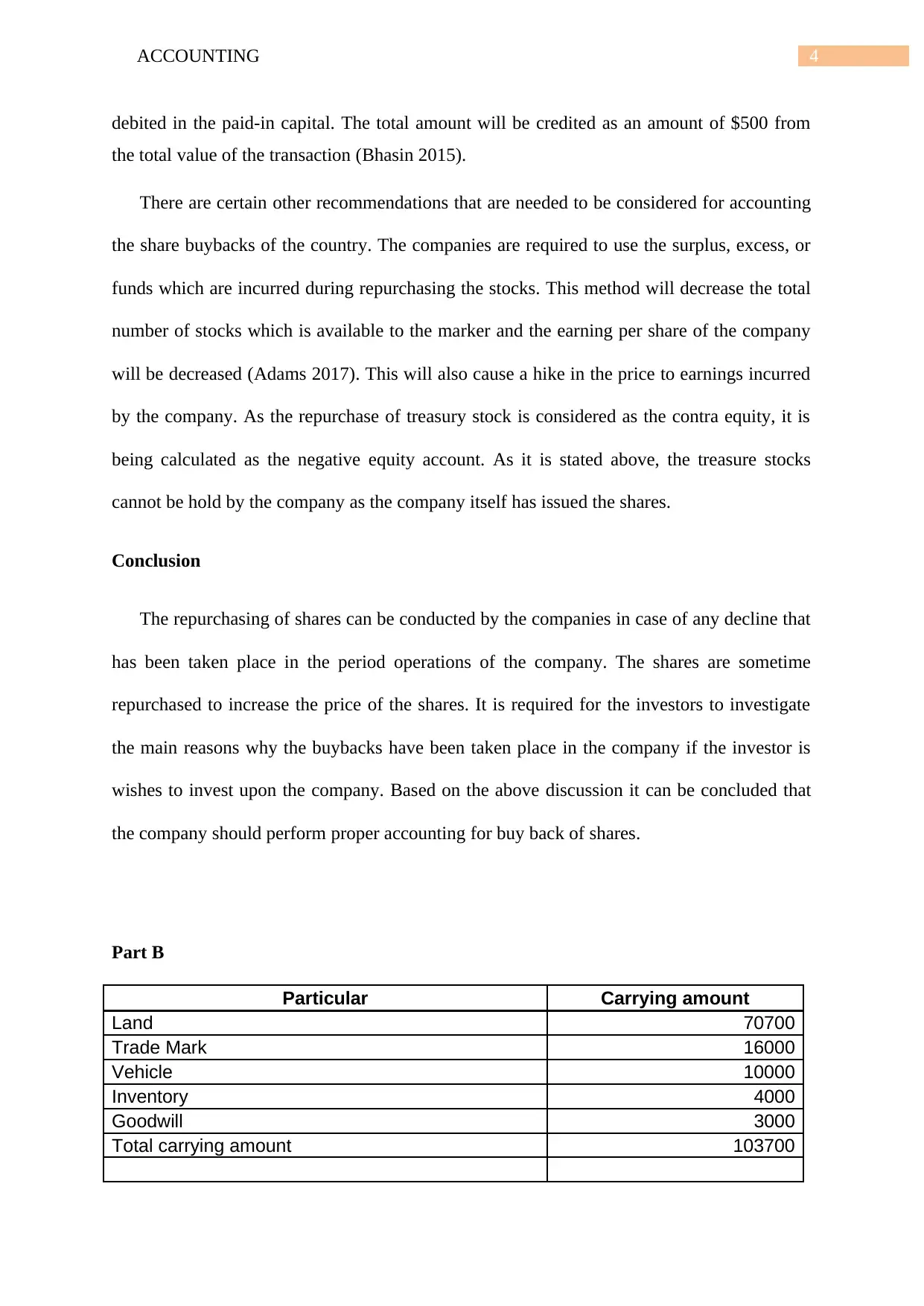
4ACCOUNTING
debited in the paid-in capital. The total amount will be credited as an amount of $500 from
the total value of the transaction (Bhasin 2015).
There are certain other recommendations that are needed to be considered for accounting
the share buybacks of the country. The companies are required to use the surplus, excess, or
funds which are incurred during repurchasing the stocks. This method will decrease the total
number of stocks which is available to the marker and the earning per share of the company
will be decreased (Adams 2017). This will also cause a hike in the price to earnings incurred
by the company. As the repurchase of treasury stock is considered as the contra equity, it is
being calculated as the negative equity account. As it is stated above, the treasure stocks
cannot be hold by the company as the company itself has issued the shares.
Conclusion
The repurchasing of shares can be conducted by the companies in case of any decline that
has been taken place in the period operations of the company. The shares are sometime
repurchased to increase the price of the shares. It is required for the investors to investigate
the main reasons why the buybacks have been taken place in the company if the investor is
wishes to invest upon the company. Based on the above discussion it can be concluded that
the company should perform proper accounting for buy back of shares.
Part B
Particular Carrying amount
Land 70700
Trade Mark 16000
Vehicle 10000
Inventory 4000
Goodwill 3000
Total carrying amount 103700
debited in the paid-in capital. The total amount will be credited as an amount of $500 from
the total value of the transaction (Bhasin 2015).
There are certain other recommendations that are needed to be considered for accounting
the share buybacks of the country. The companies are required to use the surplus, excess, or
funds which are incurred during repurchasing the stocks. This method will decrease the total
number of stocks which is available to the marker and the earning per share of the company
will be decreased (Adams 2017). This will also cause a hike in the price to earnings incurred
by the company. As the repurchase of treasury stock is considered as the contra equity, it is
being calculated as the negative equity account. As it is stated above, the treasure stocks
cannot be hold by the company as the company itself has issued the shares.
Conclusion
The repurchasing of shares can be conducted by the companies in case of any decline that
has been taken place in the period operations of the company. The shares are sometime
repurchased to increase the price of the shares. It is required for the investors to investigate
the main reasons why the buybacks have been taken place in the company if the investor is
wishes to invest upon the company. Based on the above discussion it can be concluded that
the company should perform proper accounting for buy back of shares.
Part B
Particular Carrying amount
Land 70700
Trade Mark 16000
Vehicle 10000
Inventory 4000
Goodwill 3000
Total carrying amount 103700
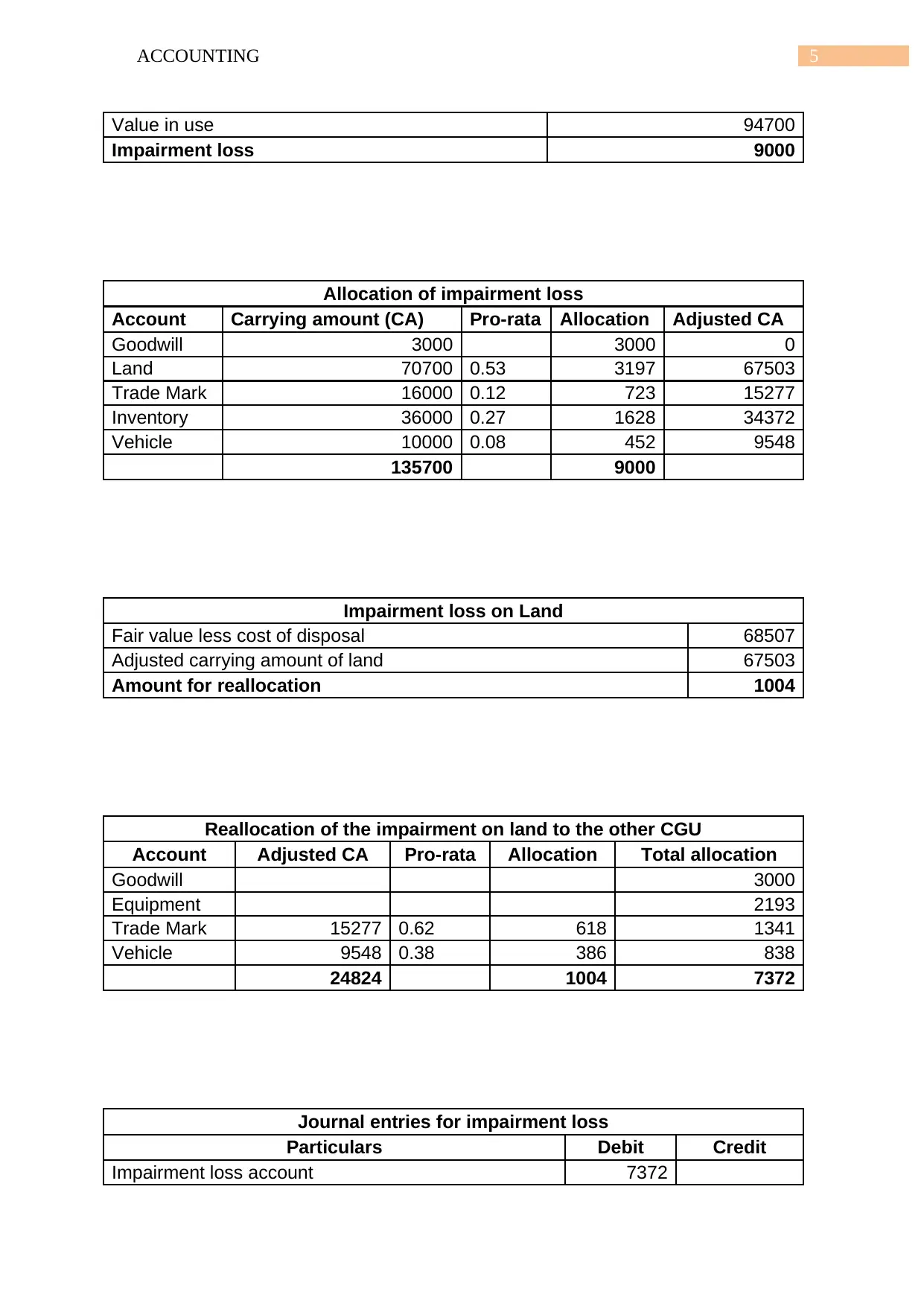
5ACCOUNTING
Value in use 94700
Impairment loss 9000
Allocation of impairment loss
Account Carrying amount (CA) Pro-rata Allocation Adjusted CA
Goodwill 3000 3000 0
Land 70700 0.53 3197 67503
Trade Mark 16000 0.12 723 15277
Inventory 36000 0.27 1628 34372
Vehicle 10000 0.08 452 9548
135700 9000
Impairment loss on Land
Fair value less cost of disposal 68507
Adjusted carrying amount of land 67503
Amount for reallocation 1004
Reallocation of the impairment on land to the other CGU
Account Adjusted CA Pro-rata Allocation Total allocation
Goodwill 3000
Equipment 2193
Trade Mark 15277 0.62 618 1341
Vehicle 9548 0.38 386 838
24824 1004 7372
Journal entries for impairment loss
Particulars Debit Credit
Impairment loss account 7372
Value in use 94700
Impairment loss 9000
Allocation of impairment loss
Account Carrying amount (CA) Pro-rata Allocation Adjusted CA
Goodwill 3000 3000 0
Land 70700 0.53 3197 67503
Trade Mark 16000 0.12 723 15277
Inventory 36000 0.27 1628 34372
Vehicle 10000 0.08 452 9548
135700 9000
Impairment loss on Land
Fair value less cost of disposal 68507
Adjusted carrying amount of land 67503
Amount for reallocation 1004
Reallocation of the impairment on land to the other CGU
Account Adjusted CA Pro-rata Allocation Total allocation
Goodwill 3000
Equipment 2193
Trade Mark 15277 0.62 618 1341
Vehicle 9548 0.38 386 838
24824 1004 7372
Journal entries for impairment loss
Particulars Debit Credit
Impairment loss account 7372
⊘ This is a preview!⊘
Do you want full access?
Subscribe today to unlock all pages.

Trusted by 1+ million students worldwide
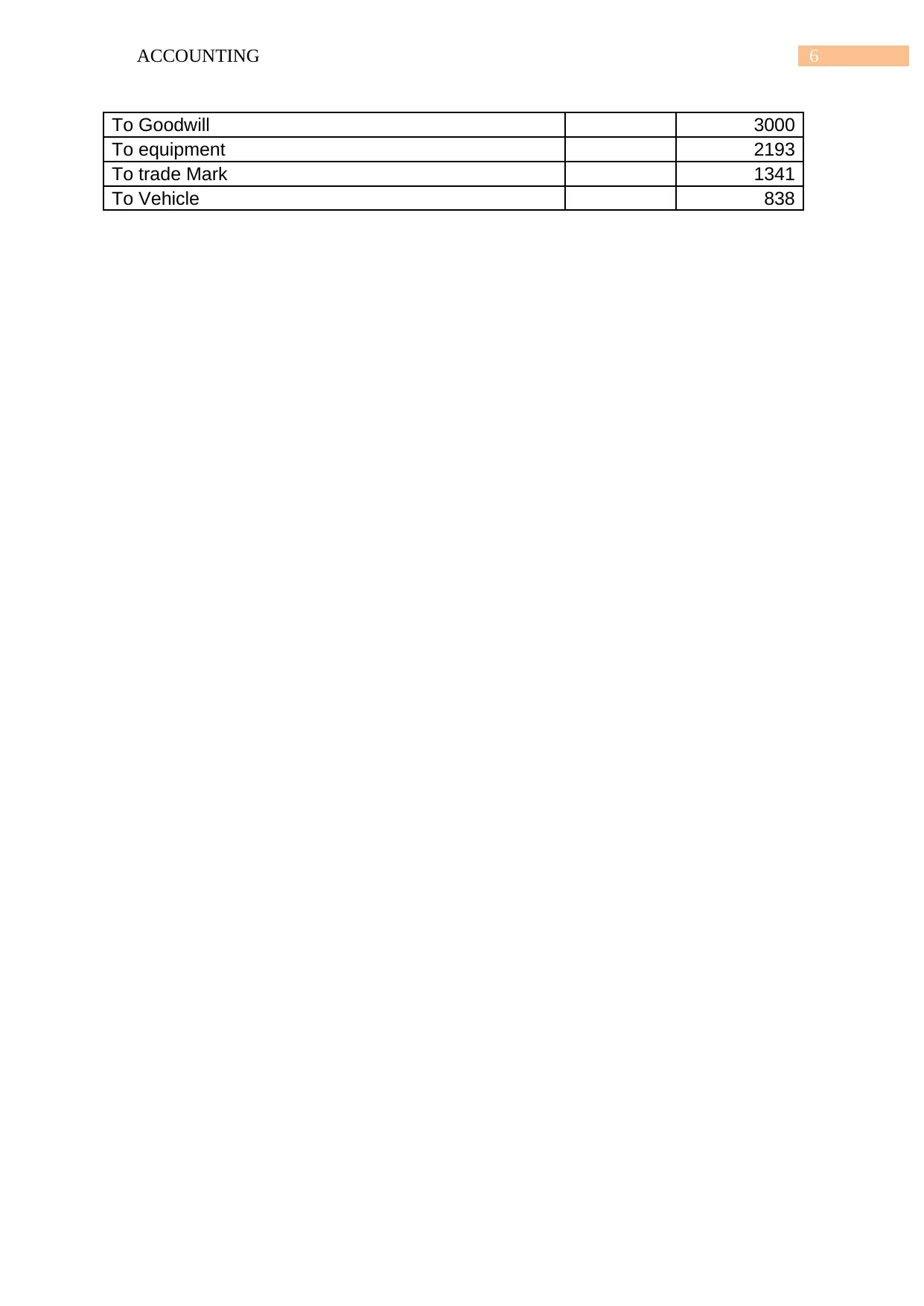
6ACCOUNTING
To Goodwill 3000
To equipment 2193
To trade Mark 1341
To Vehicle 838
To Goodwill 3000
To equipment 2193
To trade Mark 1341
To Vehicle 838
Paraphrase This Document
Need a fresh take? Get an instant paraphrase of this document with our AI Paraphraser
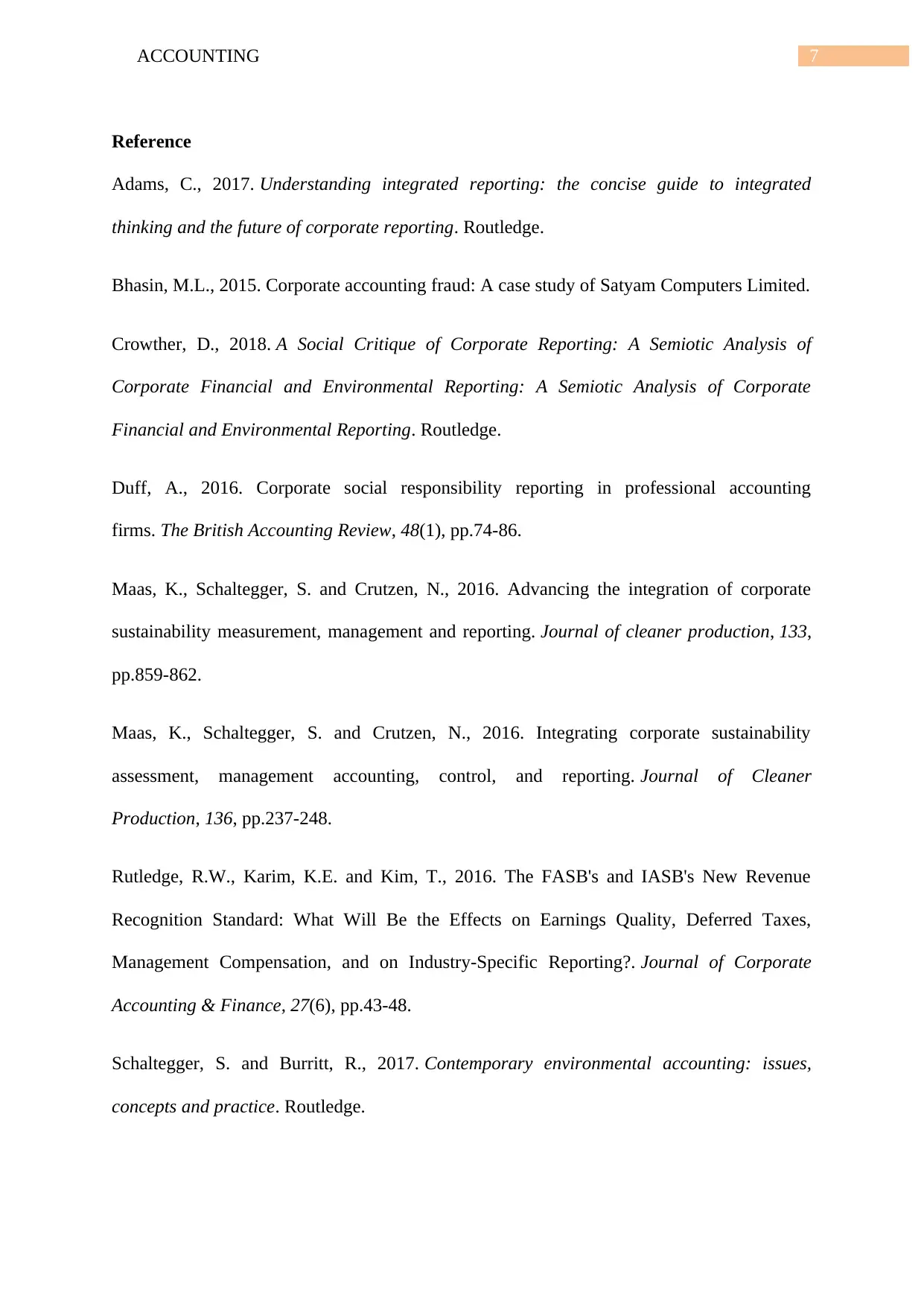
7ACCOUNTING
Reference
Adams, C., 2017. Understanding integrated reporting: the concise guide to integrated
thinking and the future of corporate reporting. Routledge.
Bhasin, M.L., 2015. Corporate accounting fraud: A case study of Satyam Computers Limited.
Crowther, D., 2018. A Social Critique of Corporate Reporting: A Semiotic Analysis of
Corporate Financial and Environmental Reporting: A Semiotic Analysis of Corporate
Financial and Environmental Reporting. Routledge.
Duff, A., 2016. Corporate social responsibility reporting in professional accounting
firms. The British Accounting Review, 48(1), pp.74-86.
Maas, K., Schaltegger, S. and Crutzen, N., 2016. Advancing the integration of corporate
sustainability measurement, management and reporting. Journal of cleaner production, 133,
pp.859-862.
Maas, K., Schaltegger, S. and Crutzen, N., 2016. Integrating corporate sustainability
assessment, management accounting, control, and reporting. Journal of Cleaner
Production, 136, pp.237-248.
Rutledge, R.W., Karim, K.E. and Kim, T., 2016. The FASB's and IASB's New Revenue
Recognition Standard: What Will Be the Effects on Earnings Quality, Deferred Taxes,
Management Compensation, and on Industry‐Specific Reporting?. Journal of Corporate
Accounting & Finance, 27(6), pp.43-48.
Schaltegger, S. and Burritt, R., 2017. Contemporary environmental accounting: issues,
concepts and practice. Routledge.
Reference
Adams, C., 2017. Understanding integrated reporting: the concise guide to integrated
thinking and the future of corporate reporting. Routledge.
Bhasin, M.L., 2015. Corporate accounting fraud: A case study of Satyam Computers Limited.
Crowther, D., 2018. A Social Critique of Corporate Reporting: A Semiotic Analysis of
Corporate Financial and Environmental Reporting: A Semiotic Analysis of Corporate
Financial and Environmental Reporting. Routledge.
Duff, A., 2016. Corporate social responsibility reporting in professional accounting
firms. The British Accounting Review, 48(1), pp.74-86.
Maas, K., Schaltegger, S. and Crutzen, N., 2016. Advancing the integration of corporate
sustainability measurement, management and reporting. Journal of cleaner production, 133,
pp.859-862.
Maas, K., Schaltegger, S. and Crutzen, N., 2016. Integrating corporate sustainability
assessment, management accounting, control, and reporting. Journal of Cleaner
Production, 136, pp.237-248.
Rutledge, R.W., Karim, K.E. and Kim, T., 2016. The FASB's and IASB's New Revenue
Recognition Standard: What Will Be the Effects on Earnings Quality, Deferred Taxes,
Management Compensation, and on Industry‐Specific Reporting?. Journal of Corporate
Accounting & Finance, 27(6), pp.43-48.
Schaltegger, S. and Burritt, R., 2017. Contemporary environmental accounting: issues,
concepts and practice. Routledge.
1 out of 8
Related Documents
Your All-in-One AI-Powered Toolkit for Academic Success.
+13062052269
info@desklib.com
Available 24*7 on WhatsApp / Email
![[object Object]](/_next/static/media/star-bottom.7253800d.svg)
Unlock your academic potential
Copyright © 2020–2025 A2Z Services. All Rights Reserved. Developed and managed by ZUCOL.





